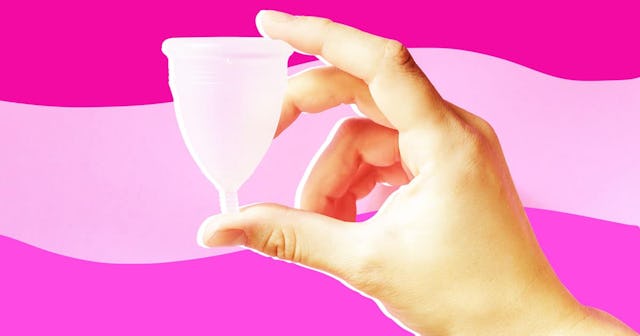Why Menstrual Cups Are Becoming So Popular

I get super heavy periods. Like the type of periods that lay you up in bed and make you hide for two days for fear of leaks, the type of periods that mean you keep extra pairs of “period panties” on hand, and wear black yoga pants to bed because you know you’ll bleed through. That happened regularly, even with the super-heavy, ridiculously-big, you’re-bleeding-like-a-postpartum-bovine tampon. Then I discovered menstrual cups.
I never went back.
Menstrual cups, as NPR says, work like this: After washing your hands, you “fold up the cup … so that the bell-shaped opening can be inserted into the vagina. Once it’s in, [you] rotate the cup 360 degrees so that it reopens. The cup will then form a seal by suctioning around the cervix.”
So you fold it in half, put it into your vagina, make sure it surrounds your cervix, and go on your merry way. Boom, Done. No changing super-heavy tampons once every half hour to make sure I don’t stain my jeans.
When it’s full, you wash your hands. You sit on the toilet. You pull it out. You dump it, wash it out, and reinsert. After your period, you wash it out and store it in a breathable little bag.
Some people get grossed out with what NPR calls “the ick factor.” Yeah, I’ll admit it: sometimes you get blood on your fingers. Guess what? It’s no different than regular blood, people; you’re just culturally conditioned to think so, and you can wash it off like it was never there. It doesn’t stain your fingers red, I promise. And better your fingers than your jeans.
For a few people, menstrual cups just don’t feel comfortable. I tried to wear one before I had children, and it didn’t fit right. But after I had kids, I can’t even feel it.
Now I’m grossed out by tampons and pads instead. Tampons leave me feeling dry and icky; menstrual cups don’t soak up all your natural vaginal lubrication the way tampons do. Not to mention tampons and pads feel like a monumental waste of money now. While the up-front cost of a Diva Cup is expensive — a Model 2, for people who’ve birthed children or have a heavy menstrual flow, runs about $30; folks with a lighter flow can get away with a cheaper cup (the smaller Lena cup, for example, holds 25 ml and costs about $25. However, menstrual cups last for ten years.
“Over time, the cup is a tremendous money saver,” wrote Malaka Gharib in NPR. “The cost of a cup represents only 5% of the cost of a 10-year supply of pads or tampons.”
Not to mention you’re not making any late-night runs to the store to pick up pads or tampons.
Maybe you’ve heard some myths about menstrual cups. But a new study in The Lancet Public Health is busting them. The meta-study looked at 43 other studies of the use of menstrual cups worldwide, which pulled data from 3,319 women and girls, according to NPR. It found cups are just as effective at preventing leaks as tampons or pads — which is super important in developing countries, or ones where water is scarce, and you need to use a lot of that precious resource to wash clothing when leaks happen.
Most importantly, according to NPR, “the researchers found no increased health risks associated with menstrual cup use among European, North American and African women and girls.” This is huge news, folks: it means access to period supplies in developing nations where period supplies (even rags and tampons) can be scarce and expensive, and girls may even have to skip school when they’re menstruating.
doble-d/Getty
NPR also says four studies found no effect on vaginal flora, which means no infections or abnormal discharge. While NPR says The Lancet wasn’t able to compare the risk of toxic shock syndrome in menstrual cups users to the risk of TSS in tampon users, because no one knows how many women actually use cups, only five cases were reported across the board.
Still reluctant or icked out? Still sound pretty difficult? After being taught how to use a cup properly, NPR says, “of the participants, 73% of women and girls reported a willingness to continue with the menstrual cup after learning how to use it and trying it out for several menstrual cycles.” That’s an enormous number, and it bodes well for the use of cups among low-income women in the UK, and women in developing countries like Malawi and Kenya. They may become more popular among non-profits now, and that would be an enormous help. Rather than perishable period items, they can pass out period solutions that last.
RubyCup has even come up with an innovation solution: for every cup you buy, they donate one to “a girl or woman without access to menstrual care products. A girl whose life will be drastically improved by this simple act of giving.” Imagine having no reliable access to period products. Imagine stressing, every month, about how you were going to deal with your period. A menstrual cup can change that.
Take the plunge. Try a cup. There are even disposable ones you can try, but frankly, they cost as much as a Diva Cup, and you might as well give the real thing a shot. I love mine, and I never use anything else. I’ve even learned that if I’m near shark week and I’m traveling, I need to bring my cup along so I avoid the ickiness of tampons. Give a cup a try.
And people, it’s only blood.
This article was originally published on